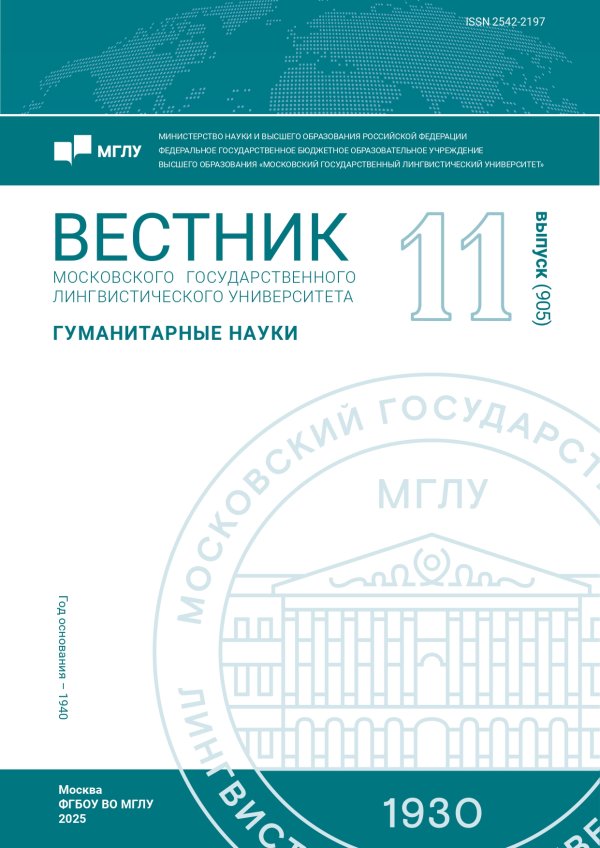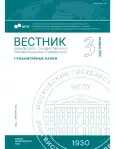№ 3(884) (2024)
Языкознание
Теоретико-методологическая основа исследований онтогенеза речи во французской лингвистике
Аннотация
В статье представлен обзор теоретико-методологических оснований исследования онтогенеза речи во французской психолингвистике. Материалом послужила серия работ французских и зарубежных лингвистов, психологов, психолингвистов, оказавших влияние на формирование исследуемой проблематики во французской науке. Результатом исследования является аналитическое представление основных гипотез формирования у ребенка речи и их развитие во французской психолингвистике.
 9-16
9-16


Теория перевода в современном Китае: направления исследований
Аннотация
В статье проводится анализ состояния современного переводоведения в Китае. Автор разделяет современную китайскую теорию перевода на три типа: переводоведение, опирающееся на древнекитайскую философскую традицию; междисциплинарные исследования по проблемам перевода; переводоведение с практическим уклоном. Исследование показало, что хотя в китайском переводоведении существует ряд учений, конкретные научные школы не сформированы, поскольку теории перевода еще не привлекла достаточного внимания в национальных академических кругах.
 17-24
17-24


Нормирование миноритарных языков: конфликт традиционных носителей и новых говорящих
Аннотация
В статье анализируется конфликт между традиционными носителями миноритарного языка и новыми говорящими, выучившими его в стандартизованной форме в рамках программ ревитализации. Автор раскрывает социально-психологическую и лингвистическую сторону этого конфликта. На примере мэнского языка показано, что обе стороны разделяют пуристические взгляды, хотя для первых чистота языка означает соблюдение норм, реально сложившихся в речевой практике, а для вторых - инновации с целью возврата к историческим корням языка.
 25-32
25-32


Блеск и нищета интерпретации: Х. Штайнталь и «достроенный Гумбольдт»
Аннотация
Статья посвящена статусу гумбольдтианства как направления в лингвистических исследованиях XIX века и ревизии претензий Х. Штайнталя на роль ученика и последователя В. фон Гумбольдта. Авторами использованы нарративный и текстологический методы исследования трудов В. фон Гумбольдта и Х. Штайнталя. Основной вывод статьи заключается в несостоятельности тезиса о миссии Штайнталя как внимательного интерпретатора и популяризатора учения Гумбольдта.
 33-40
33-40


Категории лингвистического переводоведения в концепции А. Д. Швейцера: элиминировать или применять?
Аннотация
Будучи одним из виднейших представителей отечественного лингвистического переводоведения, А. Д. Швейцер внес значительный вклад как в изучение вопросов теории и практики перевода в целом, так и в разработку их понятийно-категориального аппарата. Однако в последние десятилетия сама правомерность лингвистического подхода к переводу и использования ряда терминов, предлагаемых его сторонниками, стала ставиться под сомнение. В противовес означенной тенденции авторами статьи предпринимается попытка проанализировать ключевые термины и обосновать нецелесообразность их элиминации.
 41-47
41-47


Психологически актуальное содержание ценности «доверие» как лингвистическая база исследования «культуры доверия»
Аннотация
В статье описываются результаты экспериментального психолингвистического исследования ценности «доверие». Опираясь на теорию речевой деятельности А. А. Леонтьева и культурологическую социологию доверия П. Штомпки, автор демонстрирует, что разные аспекты содержания ценности «доверие» в процессе включения их в речевую деятельность индивида могут выполнять функцию установки. С этой целью в исследовании приводятся параметры анализа речевого действия как социально обусловленного и предлагается структурно-содержательная модель личностного смысла ценности «доверие».
 48-54
48-54


Обнаружение этнокультурной специфики социума (на материале ассоциативных полей русских, немцев, австрийцев)
Аннотация
Результативным способом изучения идентичности стал в психолингвистике анализ ассоциативных полей лексем, номинирующих ценности. Базовые ценности являются иерархической, принципиально динамичной, но синхронически устойчивой системой, что дает возможность рассматривать их как составляющую этнической идентичности. С помощью анализа ассоциативных полей устанавливается актуальное содержание ценностей, прогнозируется динамика ценностных ориентиров. Автор сравнивает ассоциативные поля справедливость и безопасность у русских, немцев, австрийцев, акцентируя значимые различия в их картинах мира.
 55-62
55-62


Актуальность личностных ценностей в сознании китайцев: на примере ценности 友善 / дружелюбие
Аннотация
В общественно-политическом дискурсе Китая личностные ценности рассматриваются как правила коммуникации в условиях межличностного общения. Анализируемая ценность тесно связана в сознании носителей языка с системой традиционных китайских ценностей. Она включается в систему базовых ценностей социализма с китайской спецификой, что свидетельствует о ее психологической актуальности для китайцев. Анализ ассоциативного поля лексемы 友善 / дружелюбие показывает, что доминирующие признаки ассоциирования на данное слово-стимул - «носитель качества», «формы и способы внешнего проявления дружелюбного отношения».
 63-69
63-69


Факторы, обусловливающие эмерджентность понимания (поликодового) текста. Часть 1
Аннотация
В статье анализируются гетерогенные факторы, которые определяют эмерджентность понимания текста. При этом эмерджентность представлена как фундаментальная характеристика психической деятельности индивида. Актуальность статьи определяется необходимостью разработки принципов анализа речевой деятельности как холистического объекта. Он является существенно эмерджентным, что детерминировано взаимообусловленностью физио-, нейро- и психологических сторон деятельности человека. Выделены факторы, определяющие эмерджентность речевой деятельности независимо от тематики, структуры, области коммуникации индивидов.
 70-78
70-78


Конструирование пространственных отношений в научно-популярном документальном кинодискурсе
Аннотация
В статье представлены методика и результаты анализа особенностей конструирования пространственных отношений в речевой модальности научно-популярных документальных фильмов на английском языке. Семантический и концептуальный анализ лексического состава начальных фрагментов научно-популярных фильмов позволил выявить состав и вариативность образ-схем, конструирующих пространственные отношения, которые в свою очередь описывают различные типы событий в научно-популярном документальном кинодискурсе.
 79-85
79-85


О вербальной, пара- и экстравербальной коммуникации (восприятие американского и британского вариантов английского языка носителями русского языка). Часть 2
Аннотация
В данной статье авторы продолжают представлять результаты проведенной ими серии экспериментов по субъективному декодированию на основе перцептивно-слухового и перцептивно-зрительного видов анализа на материале разноязычной коммуникации. Как показывают результаты проведенных экспериментов, базовые знания накапливаются и реализуются в зрительных и слуховых образах, которые дополняют друг друга. Речевая паравербалика поэтапно становится сначала дополнительным, а затем и базовым источником информации о коммуникантах и коммуникативной ситуации. Полученные результаты подтверждают также наличие оценочной констатации перцептивных признаков (например, мимики, жестикуляции, окулесики), соотносящихся с укоренившимися межкультурными особенностями поведения и межличностной коммуникации.
 86-94
86-94


Эвфемизация и рассогласование как дискурсивные стратегии комедийного кино
Аннотация
В статье эвфемизация и рассогласование в кинокомедиях изучаются как совместно реализуемые дискурсивные стратегии. Устанавливаются закономерности в выборе стратегий и их проявления на трех дискурсивных уровнях и в трех семиотических модальностях - речи, звуке и динамическом изображении. Анализ показывает, что эвфемизация реализуется в основном в речи на уровнях социокультурной и коммуникативной ситуаций, при этом рассогласование присутствует на всех трех уровнях с превалирующей реализацией в изображении и речи.
 95-102
95-102


Соотношение слухового и зрительного восприятия монгольского вокализма
Аннотация
В статье представлены результаты предварительного эксперимента, направленного на исследование взаимосвязи между слуховым и зрительным восприятием вокализма в халхаском диалекте современного монгольского языка. Эксперимент включал в себя прослушивание семи долгих и семи кратких гласных, произнесенных носителями монгольского языка (дикторами-мужчинами и дикторами-женщинами). Участники эксперимента-испытуемые фиксировали свои зрительные ассоциации цвета для каждого из произнесенных 28 гласных. Каждый из испытуемых заполнял анкету с указанием цвета, который ассоциируется с произнесенным гласным. Общее количество ответов составило 3584, полученных от 128 участников, включая 10 % взрослых и 90 % учащихся школ № 68 и № 21 в Улан-Баторе, Монголия.
 103-108
103-108


Разграничение понятий «специальная лексика» / “专业词汇” и «термин» / “术语” в русской и китайской лингвистике
Аннотация
В статье проводится анализ понятий «специальная лексика» и «термин» в языковедении России и Китая с целью установления их содержания, особенностей функционирования и места в терминосистеме. Актуальность исследования определяется необходимостью взаимной адаптации терминосистем в межкультурном общении и переводе, особенно в переводе официальных текстов, что требует детального сравнения их семантических, функциональных и стилистических особенностей и актуализирует проблему правомерности применения лингвистических терминов «специальная лексика» и «термин» в текстах разных лингвокультур.
 109-114
109-114


Именные формы глагола как активатор видовой отнесенности в нидерландском языке
Аннотация
В статье проводится анализ функционирования и особой роли именных форм глагола в нидерландском языке. К их числу относятся причастия настоящего и прошедшего времени как преморфологические и морфологические опосредованные формы выражения длительности и совершенности / завершенности глагольного действия. Проводится сопоставление означенных форм глагола в нидерландском языке и в близкородственных ему языках - немецком и английском. Рассматривается грамматическая вариативность при выражении длительности глагольного действия как характерная черта грамматического строя нидерландского языка.
 115-122
115-122


Юмор как традиция: современные тенденции развития британского ономастикона
Аннотация
В статье изучается текущее состояние британского ономастикона в части курьезных личных имен, фамилий и их сочетаний с целью выявления лингвистических и экстралингвистических причин, обусловливающих способность имени наполняться значением и создавать юмористический эффект. Исследование проведено на материале публикуемых в Сети данных об актуальных ономастических тенденциях с применением методов этимологического и лингвостилистического анализа, а также анализа активности подписчиков и гостей сайтов.
 123-129
123-129


Мотивация и проблема выбора во вторичной номинации
Аннотация
В статье рассматриваются закономерности выбора мотивировочных признаков единиц, участвующих во вторичной номинации. Материалом исследования выступают лексические единицы немецкого языка - наименования орудий труда, а также их словообразовательные и семантические дериваты. С помощью методов компонентного и трансформационного анализа определяются признаки производящих баз, профилируемые в словообразовании и семантической деривации. Устанавливается принципиальное сходство данных способов вторичной номинации при выборе семантических признаков.
 130-136
130-136


Фразеологизмы с компонентом голова в китайском и русском языках
Аннотация
В статье проведен лингвокультурный анализ китайских и русских фразеологических единиц (ФЕ) с компонентом голова. В ходе исследования выявлены универсальные и лингвоспецифические характеристики соматического компонента голова. Сходство значений ФЕ с компонентом голова в сопоставляемых лингвокультурах объясняется вхождением этого соматизма в лексическое ядро языков, что обеспечивает семантическую соотносимость ассоциаций и способов метафоризации. Вместе с тем очевидна национально-культурная специфика оснований и способов метафоризации соматических компонентов ФЕ.
 137-144
137-144


Литературоведение
Кот как лакмусовая бумажка: к вопросу об образах животных в русской словесности
Аннотация
Образы животных, встречающиеся на страницах художественных произведений, многочисленны. Образ кота / кошки относится к универсальным образам, встречающимся в фольклоре и художественной литературе разных лингвокультур. В русской лингвокультуре (шире - в славянских народных представлениях) это домашнее животное предстает в виде гендерной пары - кота и кошки и описывается как обладающее и положительными, и отрицательными качествами вследствие устойчивой, уходящей в древность архаической идеи о связи кота / кошки одновременно и с миром людей, и с потусторонним миром.
 145-150
145-150


Художественное пространство и художественное время в романе В. Я. Брюсова «Огненный ангел»
Аннотация
В статье рассмотрены две текстообразующие категории любого эстетически значимого произведения - категории художественного пространства и художественного времени. На основе анализа данных категорий в романе В. Я. Брюсова «Огненный ангел» сделан вывод о том, что художественное пространство произведения выступает как spatium-оппозиция, репрезентирующая в качестве своих «членов» пространство реальное и ирреальное, тогда как художественное время в романе, являясь сложно организованной структурой, включает в себя несколько «времен», взаимодействующих между собой различными способами.
 151-154
151-154


Культурология
Образный язык фарфора как средство пропаганды культурных доминант (опыт Советского Союза в формировании привлекательного имиджа Арктики)
Аннотация
Сегодня Россия занимает лидирующие позиции в вопросах освоения Арктики во многом благодаря достижениям Советского Союза, который проводил активную и последовательную политику по освоению Заполярья, задействовав весь потенциал страны, в том числе потенциал культуры и искусства. Статья повествует о положительном опыте СССР по формированию привлекательного образа регионов крайнего Севера через декоративно-прикладное искусство посредством выпуска тематических изделий из фарфора.
 155-162
155-162


Образ материнства как архетипический элемент православия в художественной культуре Советской России
Аннотация
В статье рассматривается образ материнства как архетипический элемент православия в советской культуре. Анализируются работы советских художников начала 20-х годов - конца 80-х годов XX века. Также в работе рассматривается регулятивная функция архетипических образов в советской художественной культуре как реорганизация исконных русских традиций в новом обществе. Делается вывод о неизменности архетипических образов православия в атеистической культуре.
 163-170
163-170












